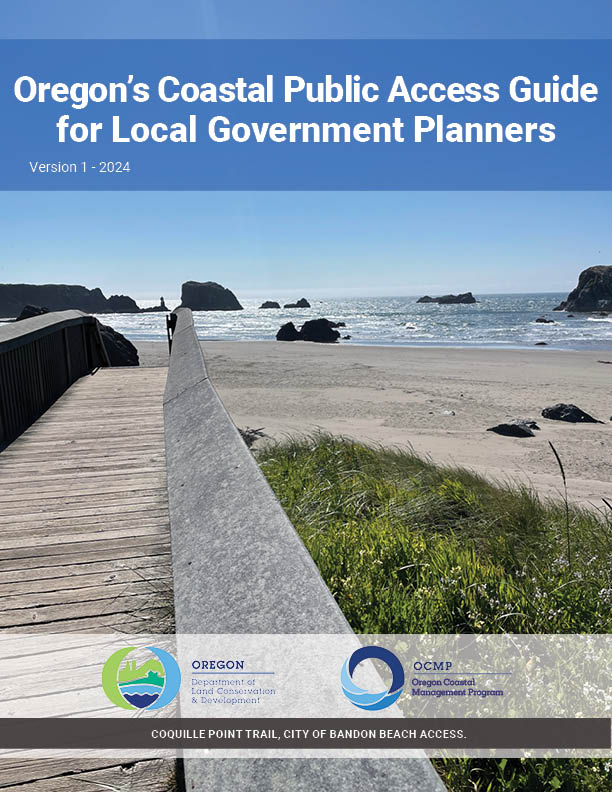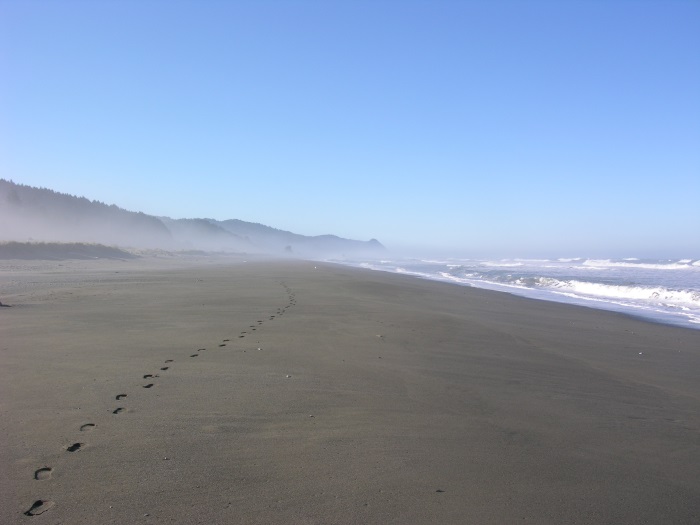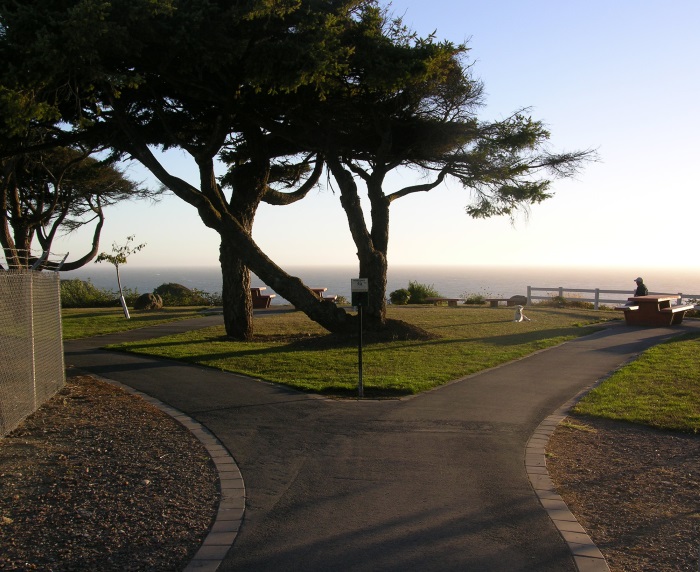Coastal Public Access Guidance for Local Government Planners
DLCD recently published the Oregon's Coastal Public Access Guide for Local Government Planners. This guide was crafted for the purpose of providing local coastal governments a framework for planning for a community's public access program. This Guide can be used by coastal city and county jurisdictions and Tribal governments as guidance for maintaining and improving coastal public access programs. Local government and tribal staff, especially land use planners, public works, and parks staff can use this guide as a roadmap to make policy and on-the-ground improvements to a community's public access to coastal shorelines and waters.
This guide includes federal and state policy analysis, survey insights, planning guidance, strategies for meaningful tribal engagement, accessibility considerations, and mapping tools. DLCD's goal is to provide suggestions and tools for local leaders to assess and improve a community's coastal access, ensuring that public spaces remain welcoming, inclusive, accessible, and resilient. In addition, the Guide provides Model Coastal Shoreland Public Access Comprehensive Plan Policy Language also provided in a Word document to use as a template for Comprehensive Plan updates.

Oregon's Coastal Public Access Guide for Local Government Planners
Model Coastal Shoreland Public Access Comprehensive Plan Policy Language
Oregon Beach Bill
 Oregonians have always enjoyed visiting the coast; a tradition that was officially protected in 1913 when Governor Oswald West and the Oregon legislature established the state's 362 miles of shoreline as a public highway. This designation only applied to the wet-sand portions of the beaches (Oregon Revised Statutes 390.605-755).
Oregonians have always enjoyed visiting the coast; a tradition that was officially protected in 1913 when Governor Oswald West and the Oregon legislature established the state's 362 miles of shoreline as a public highway. This designation only applied to the wet-sand portions of the beaches (Oregon Revised Statutes 390.605-755).
Then, in the summer of 1966, the owner of a Cannon Beach hotel put down large driftwood logs to block off a section of the beach to all but the hotel guests. In response, the State Highway Commission, with Governor Tom McCall's support, introduced two bills in the legislature. The bills mimicked a Texas law that recognized the public's continued use of private beach land as a permanent right. Commonly known as the Beach Bill, it established a permanent public easement for access and recreation along the ocean shore seaward of the existing line of vegetation, regardless of ownership. The Beach Bill also set forth a policy, under what is now the Oregon Parks and Recreation Department (ORPD), to provide public access to the beach at routine intervals.
The legislature passed the Beach Bill on June 7, 1967. It was signed into law on July 6, 1967.
Coastal Access Protections
There are two major pieces of public policy that provide and protect public access rights; the famous Oregon Beach Bill of 1967 and Statewide Planning Goal 17 Coastal Shorelands. Oregon Statewide Land Use Planning Goal 17 covers Coastal Shorelands, and among other things, requires that cities and counties in coordination with OPRD, have plans to provide public access to the beach. The goal also requires local governments to protect those access sites and replace them if they are lost for any reason. Existing public ownerships, rights-of-way, and similar public easements in coastal shorelands that provide access to or along coastal waters must be retained or replaced if sold, exchanged, or transferred. Rights-of-way may be removed to allow construction in shoreland areas, as long as public access across the site is maintained.
Coastal Access inventories
 Goal 17 requires local governments to maintain an inventory of coastal access locations. To assist with this requirement, the Oregon Coastal Management Program has funded an inventory of public access points, every ten years since 1990. The inventory records all developed and undeveloped sites that provide physical or visual access to the ocean coastline, estuaries, and coastal lakes. The data is intended to be incorporated into the Goal 17 inventories of local comprehensive plans.
Goal 17 requires local governments to maintain an inventory of coastal access locations. To assist with this requirement, the Oregon Coastal Management Program has funded an inventory of public access points, every ten years since 1990. The inventory records all developed and undeveloped sites that provide physical or visual access to the ocean coastline, estuaries, and coastal lakes. The data is intended to be incorporated into the Goal 17 inventories of local comprehensive plans.
The most recent coastal access inventory is available online.
Ocean Beach Access Plan
To help provide consistency in public access planning efforts, the Oregon Parks and Recreation Department (OPRD) and DLCD funded production of a beach access plan for the entire Oregon coast. The  Ocean Beach Access Plan is based on data from the original 1990 access inventory, and established planning goals for beach access. The plan identifies future beach access needs; lists sites which should be preserved and developed to meet those needs; provides decision criteria for identifying additional sites; and assigns the responsibilities for certain beach access management tasks to the appropriate government agency. The Plan provides local and state governments with a tool to ensure that the high quality Oregon coastal experience is maintained and enhanced in the future.
Ocean Beach Access Plan is based on data from the original 1990 access inventory, and established planning goals for beach access. The plan identifies future beach access needs; lists sites which should be preserved and developed to meet those needs; provides decision criteria for identifying additional sites; and assigns the responsibilities for certain beach access management tasks to the appropriate government agency. The Plan provides local and state governments with a tool to ensure that the high quality Oregon coastal experience is maintained and enhanced in the future.